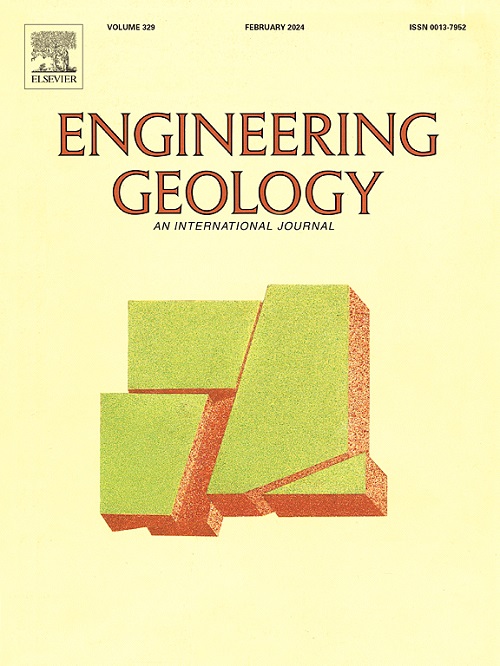台湾西南部冲积平原车瓜林断层活动断层变形带的特征分析
IF 8.4
1区 工程技术
Q1 ENGINEERING, GEOLOGICAL
引用次数: 0
摘要
由于地表变形,蠕动活动断层的活动给工程结构带来了巨大挑战。因此,量化活动断层引起的应变集中、划定活动断层变形区(AFDZ)的范围和位置、估计长期变形趋势以及预测未来变形是工程地质领域的关键。本研究综合运用详细的大地测量数据、断裂调查、形态构造分析、地质钻孔数据、生物年代学数据、放射性碳年代测定和全新世隆起率分析等多尺度分析方法,确定或确认了活动断层的位置和活动变形带的长期演化趋势。根据我们的研究结果,确定了三个活动断层面,其中一个可能是活动最频繁的主断层。此外,通过比较等时线得出的长期变形率和水准测量得出的短期变形率,我们发现存在滑移率不足的风险。这些发现对工程地质具有重要意义。作为一般贡献,我们的研究可作为类似地点的选址策略。关于我们所针对的基础设施,我们为进一步的数值模型(如三剪切模型)模拟地表变形提供了关键的输入参数,并为结构提供了重要的设计参数。考虑到所调查断层的潜在共震变形,这些结果对于未来的调查或缓解计划至关重要。本文章由计算机程序翻译,如有差异,请以英文原文为准。
Characterization of the active fault deformation zone of the Chegualin Fault in the alluvial plain of southwestern Taiwan
The activity of a creeping active fault poses significant challenges to engineering structures due to surface deformation. Therefore, quantifying the strain concentration caused by an active fault, delineating the extent and location of the Active Fault Deformation Zone (AFDZ), estimating long-term deformation trends, and predicting future deformations are crucial in the field of engineering geology.
This study comprehensively integrates multi-timescale analytical methods by incorporating detailed geodetic data, rupture surveys, morphotectonic analysis, geological borehole data, biochronological data, radiocarbon dating, and Holocene uplift rate analysis to identify or confirm the locations of active faults and the long-term evolution trends of active deformation zones. Based on our findings, three active fault planes are identified, with one possibly being the main fault with the highest activity. Furthermore, by comparing long-term deformation rates derived from isochrone lines with short-term deformation rates obtained from leveling, we observe a risk of slip rate deficit. These findings have significant implications for engineering geology. As a general contribution, our study can serve as a site screening strategy for similar locations. Regarding the infrastructure we targeted, we provide critical input parameters for further numerical models (such as the trishear model) to simulate surface deformation, and offer essential design parameters for structures. Considering potential coseismic deformation on the investigated fault, these results are fundamental for future investigations or mitigation plans.
求助全文
通过发布文献求助,成功后即可免费获取论文全文。
去求助
来源期刊

Engineering Geology
地学-地球科学综合
CiteScore
13.70
自引率
12.20%
发文量
327
审稿时长
5.6 months
期刊介绍:
Engineering Geology, an international interdisciplinary journal, serves as a bridge between earth sciences and engineering, focusing on geological and geotechnical engineering. It welcomes studies with relevance to engineering, environmental concerns, and safety, catering to engineering geologists with backgrounds in geology or civil/mining engineering. Topics include applied geomorphology, structural geology, geophysics, geochemistry, environmental geology, hydrogeology, land use planning, natural hazards, remote sensing, soil and rock mechanics, and applied geotechnical engineering. The journal provides a platform for research at the intersection of geology and engineering disciplines.
 求助内容:
求助内容: 应助结果提醒方式:
应助结果提醒方式:


